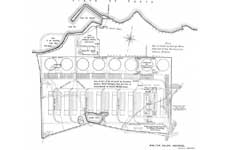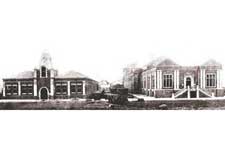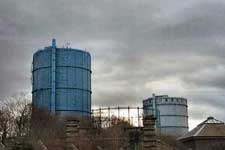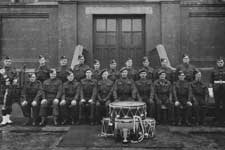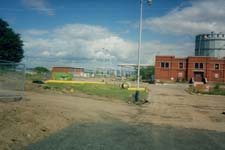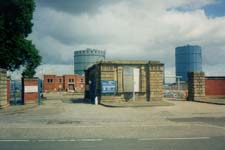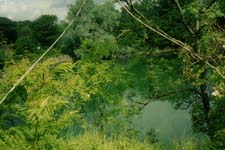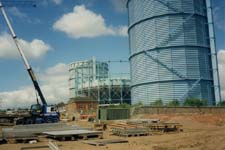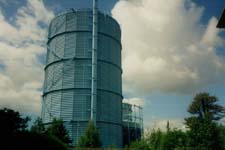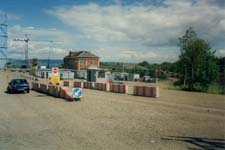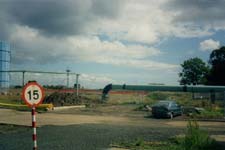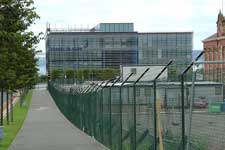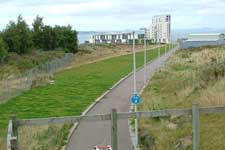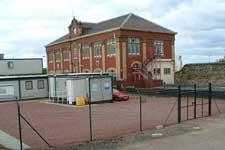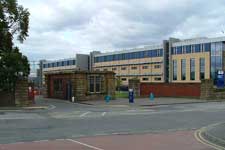Granton Gas Works
On this page
- History of gas production and use
- Why was Granton Gas Works needed?
- Design and construction
- Gas distribution in Edinburgh and Leith
- Manufacturing process
- Other features
- Development over the years
- World War II
- Demolition
- What's there now?
- The Gas Works railways (on new page)
- Further information (on new page)
History of gas production and use
For centuries, lighting in buildings was by candles and later by lamps using liquid fuel such as whale oil and later paraffin. By the 1820s gas lighting ![]() . was being used and gas works were built which converted coal into gas – for example at New Street, Edinburgh and Baltic Street, Leith. A system of pipes was laid under the streets to carry the gas to the buildings where it was to be used, and meters installed to measure the gas used so that customers could be correctly charged for it. The early gas lamps used flat nozzles (burners) which gave a fan-shaped flame. The gas was simply lit and the flame adjusted to burn yellow. Around 1890 a major improvement was made when Carl Auer von Welsbach introduced the incandescent mantle. This was a mesh impregnated with chemicals – 'rare earths' as they were called at the time – which glowed a brilliant white when heated. The gas flame could then be a properly adjusted efficient one, burning at an almost invisible blue inside the mantle.
. was being used and gas works were built which converted coal into gas – for example at New Street, Edinburgh and Baltic Street, Leith. A system of pipes was laid under the streets to carry the gas to the buildings where it was to be used, and meters installed to measure the gas used so that customers could be correctly charged for it. The early gas lamps used flat nozzles (burners) which gave a fan-shaped flame. The gas was simply lit and the flame adjusted to burn yellow. Around 1890 a major improvement was made when Carl Auer von Welsbach introduced the incandescent mantle. This was a mesh impregnated with chemicals – 'rare earths' as they were called at the time – which glowed a brilliant white when heated. The gas flame could then be a properly adjusted efficient one, burning at an almost invisible blue inside the mantle.
The use of gas gradually increased during the 19th century and towards the end of the century was growing quite rapidly despite the availability of electric lights by this time. As well as lighting, gas was also being used by then for other purposes such as powering factory machinery by gas engines.
The following table shows gas production in thousands of cubic feet at the works in the Edinburgh area (Portobelo was outside the supply area before 1896 when it became part of Edinburgh):
| Year | Edinburgh | Leith | Portobello |
|---|---|---|---|
| 1894-95 | 1,001,817 | 487,497 | (no data) |
| 1900-01 | 1,145,568 | 641,143 | 32,837 |
Why was Granton Gas Works needed?
In the 1890s gas was being produced at:
- the Edinburgh Gas Works in New Street, later replaced by a bus garage and in 2007 the subject of an archaeological investigation (this is part of the site of the proposed Caltongate development);
- the Leith Gas Works, Baltic Street, now part of Keyline Builders Merchants;
- Portobello Gas Works, Pipe Street, Portobello.
Edinburgh and Leith were then separate burghs, but their gas production and supply were managed by a joint board, the Edinburgh and Leith Corporations Gas Commissioners (ELCGC). Portobello was a separate burgh until 1896 but amalgamated with Edinburgh that year, following which their gas works came under the control of ELCGC.
By the 1890s these works were operating at full capacity. The New Street and Portobello sites were hemmed in by other buildings and could not be expanded. At Leith it might have been possible to expand onto an adjacent site. But it was considered that a new works on a much larger site would allow for future growth and allow modern processes to be introduced.
Design and construction
At a meeting on 15 February 1897 ELCGC appointed a new Chief Engineer and Manager, Walter Ralph Herring M Inst C E, at a salary of £900 per year. He came to the organisation from Huddersfield Corporation Gas Department, and had written a large (458 page) book entitled ‘The Construction of Gas Works Practically Described’. He took up his position in spring 1897.
Mr Herring seems to have started work at once on proposals for a new gas works. Two sites were considered – one at the east end of Leith Docks and one at Granton.
Town gas![]() is produced by the ‘gasification’ of coal in retorts, a process which produces gas, coke and also various by-products such as coal-tar and ammonia.
is produced by the ‘gasification’ of coal in retorts, a process which produces gas, coke and also various by-products such as coal-tar and ammonia.
Large quantities of coal were required, and in the days before road transport as we know it today rail access was therefore essential. (By 1926, Granton Gas Works was using 200,000 tons of coal a year.) The existing Edinburgh and Leith works both had rail access, but only from the North British Railway (NBR), and a factor if favour of Granton was access both from the NBR and its rival, the Caledonian Railway (CR). In addition, it was close to the sea so that supplies could be brought by boat – useful in the event of strikes on the railway. The ELCGC thought of building their own small harbour at Granton, but this did not go ahead.
Following negotiation with the 6th Duke of Buccleuch![]() , a 106¼ acre site at Granton which had formed part of his estate was purchased for £124,000.
, a 106¼ acre site at Granton which had formed part of his estate was purchased for £124,000.
At the time, the site was in Midlothian, not in either Edinburgh or Leith. Subsequent expansion of the city boundaries in 1900, when the Gas Works was still under construction, brought it into Edinburgh. Edinburgh and Leith subsequently amalgamated in 1920 and the gas undertaking passed to Edinburgh Corporation.
The works were carefully laid out, with ease of transport in mind. Work started in October 1898 and was largely complete by 1902 when the official opening by Mrs Steel, wife of the Lord Provost of Edinburgh, assisted by Mrs Mackie, wife of the Provost of Leith, took place and production started on 21 October 1902. Further work was done from 1903 to 1910.
Acknowledgement
I am grateful to the City of Edinburgh Council (CEC) Department of Culture and Leisure for permission to use this image, which is from the Descriptive Pamphlet written by Walter Ralph Herring MInstCE and published by Edinburgh & Leith Corporations Gas Commissioners for the opening of the Gas Works on 27 February 1902.
A full copy of the Pamphlet is available in the Edinburgh Room, Central Library, George IV Bridge, Edinburgh.
No reproduction, transmission, performance, display, rental, lending or storage in any retrieval system of the image is permitted without the written consent of the Intellectual Property Rights holder and CEC.
The author of the image is believed to be the former Edinburgh & Leith Corporations Gas Commissioners.
Downloading of the image for use by third parties and end users is strictly prohibited, except for private study. Downloading of the image for commercial purposes will be treated as a serious breach of copyright and legal action will be taken by CEC.
The design for the gas works allowed for considerable future expansion, and was never fully built.
The main entrance was on West Granton Road, where offices were also constructed. To the north of that were buildings containing the coal store and, adjacent to that, the retort house where the actual gas production took place. These buildings were in a distinctive style and constructed mainly of red brick, with stone used for some of the details. The front of the plant house, attached to the coal store, featured a decorative roof in the form of a truncated pyramid.
Acknowledgement
I am grateful to the City of Edinburgh Council (CEC) Department of Culture and Leisure for permission to use this image, which is from the Descriptive Pamphlet written by Walter Ralph Herring MInstCE and published by Edinburgh & Leith Corporations Gas Commissioners for the opening of the Gas Works on 27 February 1902.
A full copy of the Pamphlet is available in the Edinburgh Room, Central Library, George IV Bridge, Edinburgh.
No reproduction, transmission, performance, display, rental, lending or storage in any retrieval system of the image is permitted without the written consent of the Intellectual Property Rights holder and CEC.
The author of the image is believed to be the former Edinburgh & Leith Corporations Gas Commissioners.
Downloading of the image for use by third parties and end users is strictly prohibited, except for private study. Downloading of the image for commercial purposes will be treated as a serious breach of copyright and legal action will be taken by CEC.
To the north of these buildings was the purifying plant and smaller buildings containing the meter house, in which were two large meters, and the pumping station, to move gas through the pipes.
Further north was the gasholder. Only one was initially built, although eight were allowed for in the initial design. (Had they all been built, Granton House would have had to be demolished.) The gasholder is now a listed building![]() .
.
To the east of the retort house was the railway station. The building there also contained the time office – workers were required to pass through turnstiles on their way into and out of the works. This building also contained lavatories, bathrooms, and lockers for the men to store their outdoor clothing. A footbridge over the railway lines led to the works itself.
The total cost of the works, excluding the Products Works was £450,000.
The following is a quotation from ‘The Buildings of Scotland – Edinburgh’ by John Gifford, Colin McWilliam and David Walker, published in 1984:
“...today's prosaic installations have little in common with the bizarre and stately architecture designed for the Edinburgh and Leith Corporation Gas Commissioners by W R Herring in 1898, all red brick with yellow trim. Main gate, originally arched, then four rows of buildings. Coal-stores with French hats on top, retort houses behind (No 2 only survives). Purifying houses (all gone). Laboratory, meter house and pumping station, three big identical rectangles with bulging pavilion roofs (carried on delicate space-frame). Finally, tall gas-holders; one of a projected row of eight was built to Herring's design, with a steel frame of extraordinary delicacy, then the fixed and louvred one to the west in 1933 and another to the east in 1966. Along the east side the gasworks' own passenger station and seventeen-bay, two-aisle workshops.”
Manufacturing process
Coal was delivered train and tipped straight from the wagons onto a conveyor belt below the level of the tracks. It was then kept in the coal store until required. When needed it was taken the retort house, again by conveyor belts, and fed into the retorts – a series of arch-shaped fireclay tubes, each 20’ long and 22½” by 15¼” high. The coal was measured and placed into the retorts by chutes with hydraulic valve controls. The retort house was said at the time to be probably the largest in the world and could handle 1000 tons of coal a day.
The retorts were heated by furnaces below them, causing gas to be expelled from the coal. This process took about four hours, a temperature of 1500 degrees Fahrenheit (over 800 degrees Centigrade) being required. What remained was coke, which was cooled with a water spray as it was removed from the retorts and taken by conveyor to railway wagons for transport. Smaller material, ‘screenings’, was removed and used to make ‘briquettes’.
The gas was then drawn out by exhausters and passed through condensers to reduce its temperature. It then had to be purified to remove tar and oils from it. The gas was washed with ‘ammoniacal solution’ and subsequently treated with fresh water to remove the ammoniacal solution. The resulting ‘ammoniacal liquor’ was used at the Products Works to make sulphate of ammonia (ammonium sulfate![]() in modern terminology). This was sold for use as an agricultural fertiliser.
in modern terminology). This was sold for use as an agricultural fertiliser.
The gas itself then went on to be further treated with hydrate of lime to remove carbon dioxide, sulphuretted hydrogen (hydrogen sulfide), carbon bisulphide and then treated again with hydrated oxide of iron (iron III hydroxide) to remove all traces of sulphuretted hydrogen.
The gas then passed through the meters where the quantity was carefully recorded and was then piped to the gasholder.
Gas distribution in Edinburgh and Leith
Granton Gas Works was not in the centre of the area it served. At the same time as it was being built, new pipes were laid to carry the gas to where it would be used. The largest of these was four feet in diameter (1219mm) and ran from Granton under the streets to Canonmills, where there was a ‘gas station’ with a number of gasholders in two groups, one east of Inverleith Row and one west. From there, smaller pipes took the gas to other gas stations, and to the customers. A pump at Granton Gas Works, driven by a gas engine, kept up pressure in the pipe network.
The four foot (48”) main was 4412 yards long (over 2½ miles / 4 km) and cost £31,850-18-0 (£31,850.90) to construct.
A 24” main from Crewe Toll to Morningside Place, 6949 yards long, cost £14,761-16-8½ (£14,761.83) and a further 15” main from Ferry Road to Craighall Road, 2539 yards, cost £2818-15-6½ (£2,817.78).
The main gas stations were located at:
- Canongate (opposite the present Royal Mile Primary School)
- Holyrood Road (near Holyrood Park entrance)
- Portobello (at gas works, between Pipe Street and Tower Street)
- Blandfield (on Broughton Road, opposite Powderhall refuse depot)
The Canonmills site is now occupied by office buildings used until recently by Standard Life. The section of pipe near the Granton Gas Works was removed a few years ago as part of the preparatory work to allow new development in the area.
Development over the years
Ownership of the gas works was as follows:
- Edinburgh & Leith Corporations Gas Commissioners – construction – 1920
- Edinburgh Corporation 1920 – 1949
- Scottish Gas Board 1949-1973
- British Gas 1973-closure (BG subsequently ceased to exist 1997)
Over the years, various additions and alterations were made. The most obvious were the additions in 1930 of Gasholder No 2 and in 1966 of Gasholder No 3. These did not follow the design of Gasholder No 1. Gasholder No 1 was a waterless gasholder, 165 feet high with a capacity of 5 million cubic feet; Gasholder No 3 was 275 feet high.
Other buildings were added in the 1930s, 1940s and 1950s and in the 1960s the works were adapted to deal with natural gas piped from the North Sea via Grangemouth. A major appliance conversion programme, to allow gas customers to use natural gas, took place with the changeover from manufactured to natural gas.
Manufacture of gas at Granton finally came to an end in 1987. The gasholders continued in use for storage for a few more years, Gasholder No 1, although the oldest, remaining in use longest – until 2001.
Demolition of redundant buildings and removal of equipment had started well before that, but after closure the site was largely cleared. Gasholder No 3 was demolished in 2003, and Gasholder No 2 in 2004. Gasholder No 1 is reportedly also threatened with demolition.
Other features
There were a number of by-products from the process of producing gas, principally ammonia and tar. These were dealt with on a separate part of the site, to the north west of the gas works. Various industrial chemicals were produced for sale.
A network of lines connected to the national rail network served the works. Coal was brought in in standard mineral wagons, which in addition to side doors had one end door. The coal was normally tipped using the end door, one end of each wagon being lifted off the track by a hydraulic ram to allow this. Up to 500 tons an hour could be unloaded. Wagons with bottom doors could also be accommodated.
The ELCGC had their own fleet of wagons, painted with their initials in large letters, but no doubt most of the coal would arrive in wagons owned or leased by the various collieries that produced the coal (‘private owner wagons’).
In addition to coal from relatively local sources, such as the Lothians, a certain amount was brought from further away, to provide a mixture with the required qualities for gas production.
For the benefit of those working at the gas works, a private railway station was built, which still exists although the trackwork has been lifted. The building has recently been restored. Trains were run from Princes Street Station Edinburgh (‘the Caley station’) stopping at Dalry Road, Murrayfield and Craigleith. The gas works station did not appear in the published timetables but local residents apparently did use them. Like the surviving gasholder, the station is a listed building![]() . This station has sometimes been referred to recently as Granton Station, but the actual Granton Station was on the Middle Pier at Granton Harbour.
. This station has sometimes been referred to recently as Granton Station, but the actual Granton Station was on the Middle Pier at Granton Harbour.
The Gas Works also had a network of standard gauge and narrow gauge lines, and its own locomotives.
World War II
During the World War II, the Gas Works was a target for bombing, although it was not actually hit.
During the war, a home-based force was set up to defend the UK. They were mainly men who were not called up to the regular forces for one reason or another, for example because they were too young or too old. The Gas Works had its own Home Guard troop, shown in the photograph below, taken at the Gas Works Compressor House in 1943. Major Reynolds in the photograph below was a long-term employee at the Gas Works.
Acknowledgement
I am grateful to Mike Cooper for sending this picture and allowing the use of it. Copyright remains with him – do not use the image without permission. If you wish permission, or if you have any information about the Home Guard at the Gas Works, please contact me .
Demolition
These photographs were taken at the time when the gas works site was being cleared for redevelopment.
What's there now?
The main surviving features of the gas works are walls at the main entrance, Gasholder No 1 and the railway station building and platform.
New buildings have been built on parts of the site – these include the Scottish Gas offices, Edinburgh's Telford College and housing developments.
The link below lets you download a two page A4 size leaflet, designed to be folded to one-third A4.
Adobe Reader is needed to read the pdf document – if it is not installed on your computer, click the icon below for a free download.

